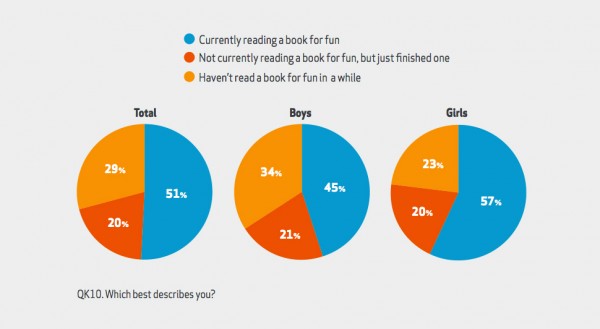2018 School Spending Survey Report
Scholastic’s New Report Examines Kids' Attitudes on Reading
The “Kids & Family Reading Report, 5th Edition” survey from Scholastic launched on January 8 with findings, including what kids are reading for fun, the makings of a frequent reader, and what kids want to read.
 The divide between frequent and infrequent readers is marked in Scholastic’s “Kids & Family Reading Report, 5th Edition” survey, conducted in conjunction with YouGov, an internet-based market research firm. The report found that while 51 percent of children ages 6-17 are currently reading a book for fun, 97 percent of frequent readers (FR), or children who read books for fun 5-7 days a week, say they are currently reading a book for fun or have just finished one (from the same age group). Meanwhile, an overwhelming 75 percent of infrequent readers (IR), or children who read books for fun less than one day a week, say they haven’t read a book for fun in a while. FRs (ages 6-11) read an average of 43.4 books a year while IRs clock in at 21.1 books annually. The gap is even more substantial as kids get older. Among ages 12-17, FRs read 39.6 books a year and IRs read a mere 4.7. Released on January 8, the report also found that 75 percent of parents with children 6-17 say that strong reading skills are the most important skill a child could have, while 54 percent of kids agreed. Eighty-six percent of parents say reading books for fun is extremely or very important compared to 46 percent of kids. Parents (of children in the same age range) also responded that “I wish my child would read more books for fun” (75 percent) and “I wish my child would do more things that did not involve screen time” (71 percent).
The divide between frequent and infrequent readers is marked in Scholastic’s “Kids & Family Reading Report, 5th Edition” survey, conducted in conjunction with YouGov, an internet-based market research firm. The report found that while 51 percent of children ages 6-17 are currently reading a book for fun, 97 percent of frequent readers (FR), or children who read books for fun 5-7 days a week, say they are currently reading a book for fun or have just finished one (from the same age group). Meanwhile, an overwhelming 75 percent of infrequent readers (IR), or children who read books for fun less than one day a week, say they haven’t read a book for fun in a while. FRs (ages 6-11) read an average of 43.4 books a year while IRs clock in at 21.1 books annually. The gap is even more substantial as kids get older. Among ages 12-17, FRs read 39.6 books a year and IRs read a mere 4.7. Released on January 8, the report also found that 75 percent of parents with children 6-17 say that strong reading skills are the most important skill a child could have, while 54 percent of kids agreed. Eighty-six percent of parents say reading books for fun is extremely or very important compared to 46 percent of kids. Parents (of children in the same age range) also responded that “I wish my child would read more books for fun” (75 percent) and “I wish my child would do more things that did not involve screen time” (71 percent). Predictors For frequent reading
According to the report, the three most powerful predictors for frequent reading in children ages 6-17 are when kids are more likely to rate themselves as “really enjoying reading,” have a strong belief that reading for fun is important, and have parents who are frequent readers. Other predictors among ages 6-11 include reading aloud early and often and spending less time online using a computer. From ages 12-17, predictors are reading a book of choice independently in school, ereading experiences, have a large home library, have been told their reading level, and have parents involved in their reading habits.READING FROM BIRTh, READING FROM HOME, AND READING IN SCHOOL
Seventy-three percent of parents with kids ages 0-5 respond that they started reading aloud to their kids before age one. (Only 30 percent say they began before the age of three months.) Sixty percent of parents with children ages 0-5 have received advice that children should be read aloud to from birth. Parental income plays a factor: Forty-seven percent of parents in the lowest income households say they received this reading-from-birth advice compared to 75 percent of parents from the highest income households. Fifty-four percent of children ages 0-5 are read aloud to at home 5-7 days a week. In kids ages 6-8 and 9-11, this figure drops to 34 percent and 17 percent respectively. Forty percent of kids ages 6-11, who were read aloud to at home by parents, wish their parents had continued the practice. In lower income families, schools play a bigger role with kids regarding reading books for fun. Sixty-one percent of kids ages 6-17 from the lowest-income homes say they read for fun mostly in school or equally at school and at home, while 32 percent (in the same age group) from the highest income homes say the same.
From "Kids & Family Reading Report, 5th Edition."
What Kids Want in Books
All in all, kids want books they’ve chosen themselves, says 91 percent of kids ages 6-17. They also want books that make them laugh—that’s what 70 percent of kids ages 6-17 answered. Other wants: books that make them use their imagination (54 percent), books that tell a made-up story (48 percent), books that have characters I wish I could be like because they’re smart, strong, or brave (43 percent), books that teach me something new (43 percent), and books that have a mystery or a problem to solve (41 percent).Print and Ebooks
The percentage of children who have read an ebook has increased across the board since 2010—25 percent versus 61 percent today. However, 77 percent of children who have read an ebook say that most of the books they read are in print, and nearly 65 percent say they’ll always want to read books in print.This study was fielded between August and September 2014 and includes 506 parents of children ages 0-5; 1,026 parents of children ages 6-17; and one child ages 6-17 from the same household.
RELATED
RECOMMENDED
CAREERS
The job outlook in 2030: Librarians will be in demand
CAREERS
The job outlook in 2030: Librarians will be in demand
ALREADY A SUBSCRIBER? LOG IN
We are currently offering this content for free. Sign up now to activate your personal profile, where you can save articles for future viewing






Add Comment :-
Comment Policy:
Comment should not be empty !!!
Mary Alice Deveny
Carolyn, Thank you for your excellent summary of this important updated report. I would like to place a link to it from my website, and highlight the info on ages 0-5, with your permission. Mary AlicePosted : Jan 10, 2015 12:30